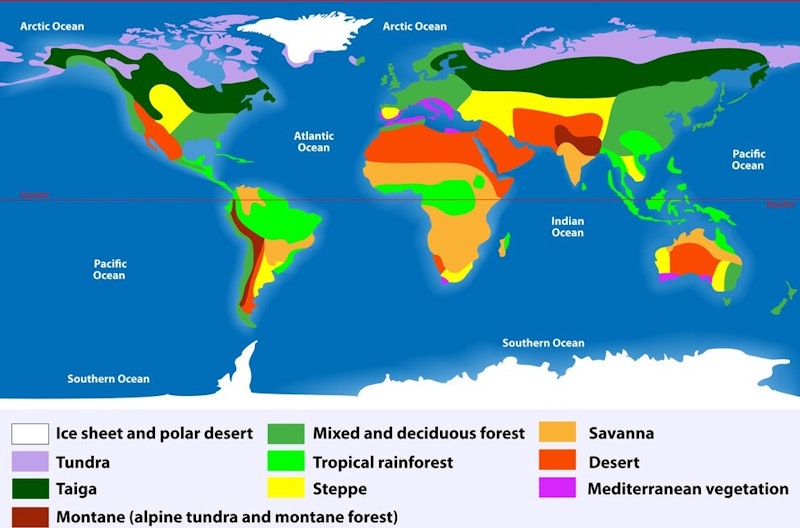Study Notes
GCSE Geography | Global Biomes (Ecosystems 4)
- Level:
- GCSE
- Board:
- AQA, Edexcel, OCR, Eduqas
Last updated 17 Oct 2024
A biome is a large-scale ecosystem, it’s characteristics are defined by abiotic factors (non-living environmental factors), and they are known by their dominant type of vegetation, such as the tropical rainforest or taiga.
Global biomes form broad belts following lines of latitude - this is because their climate is dictated by global atmospheric circulation (see separate study notes). Variations in vegetation are due to distance from the sea, ocean currents, winds, geology and soils, altitude and relief, for example...
- Altitude - temperature falls with height above sea level - this is because the air is thinner so cannot retain as much heat. As a result trees are replaced by tough grasses on steep mountains.
- Ocean currents - cold ocean currents create dry conditions because of a lack of evaporation, whereas the warm Gulf Stream current makes countries in western Europe warmer than they should be due to their latitude.
- Mountain ranges - these force air to rise upwards leading to relief rainfall over mountainous areas, but this means moisture is quickly lost so the land the other side of the mountain range is dry (this is known as the rain shadow).

The characteristics of global biomes
Tropical rainforests
Tropical rainforests lie along or close to the equator and can be found in South America, Africa, South-east Asia and Australia. Here the sun's rays are concentrated which means the high temperatures cause evaporation, and the moist air that rises leads to heavy rainfall with little seasonal variation. This belt of low pressure along the equator creates ideal conditions for plant growth, which is why the vegetation is so lush. Rainforests cover approximately 6% of the Earth's land surface, however they are home to more than 50% of all animal and plant species, and provide the ingredients for 25% of all medicines.

Hot deserts
Deserts lie roughly 30° north and south of the Equator, close to the Tropics of Cancer and Capricorn. Here the sun's rays are still very concentrated, but the air is sinking here which means that clouds don't form so the air is very dry, resulting in a high pressure belt and arid conditions. The lack of cloud means that temperatures are high during the day, but plummet overnight. The conditions in the desert biome are extremely harsh, so animals and plants have to be well adapted to survive.

Tropical grasslands (Savanna)
Savanna grasslands lie between 15 and 30 degrees north and south of the equator - between tropical rainforests and hot deserts. This biome has distinct wet and dry seasons due to the Hadley cell - the dry season is longer and can be extremely hot with wildfires common, whereas the wet season can see torrential downpours and intense thunderstorms. Savanna grasslands are characterised by few trees and are home to large grazing animals such as giraffes, elephants and zebras, along with predators such as lions and cheetahs.

Temperate grasslands (Eastern European Steppes and North American Prairies)
Temperate grasslands lie around 40 degrees north and south of the Equator, inland so they experience hot summers and cold winters (as they don't benefit from the seasonal warming and cooling effects from the sea). This biome is dominated by short tussock and feather grasses and the land is mainly used for grazing.

Mediterranean
The Mediterranean biome lies around 40 degrees north and south of the equator, in southern Europe, California (USA), South Africa and Western Australia, and is characterised by hot and dry summers and mild winters. Vegetation includes small drought resistant trees and evergreen shrubs, as well as olive trees and citrus trees (such as oranges and lemons).

Deciduous forests
Deciduous forests lie in higher latitudes, roughly between 50 and 60 degrees north of the Equator in places such as western Europe and North America. The climate tends to be quite wet due to the Jet Stream bringing in rain - deciduous trees lose their leaves during the winter to retain moisture, but also because there is less opportunity for photosynthesis with reduced sunshine.

Coniferous forests (Taiga)
Coniferous forests are found roughly 60 degrees north of the Equator, in places such as Scandinavia, Canada, and northern Russia. Winter is bitterly cold in this biome - because of the earth's tilt there is very little sunlight for several months. Coniferous trees have needles instead of leaves which retain heat and moisture during the cold dark winters, they are also evergreen meaning that they can maximise photosynthesis during the short summers.

Tundra
The tundra lies from about 60-70 degrees north to the Arctic Circle, in Northern Europe and Canada. This biome experiences very cold, windy and dry conditions (below freezing for most of the year) due to the angle of solar radiation, meaning the sun's rays are spread out over a large area. The land is frozen for much of the year, and when it is not frozen the surface ice thawing leads to waterlogging. Plants and animals are well adapted to survive the cold, for example, plants are low growing to withstand the wind and retain heat and moisture. The tundra is fragile and threatened by oil and mineral exploitation and tourism.

Polar
The polar biome lies within the Arctic and Antarctic circles - cold air sinks here so the temperatures are extremely low (can drop to -50°C) and there is very little precipitation, making the poles officially deserts. The main polar regions are Antarctica and Greenland, where the land is permanently frozen. There are very few plants and animals in this biome as conditions are so harsh.

You might also like
Ecosystem Succession
Study Notes

World’s largest desert has grown even larger
5th April 2018
Past extinctions inform scientists about what's to come for our mammals.
7th September 2020
Ecosystems | AQA GCSE Geography
Quizzes & Activities
Daily Email Updates
Subscribe to our daily digest and get the day’s content delivered fresh to your inbox every morning at 7am.
Signup for emails